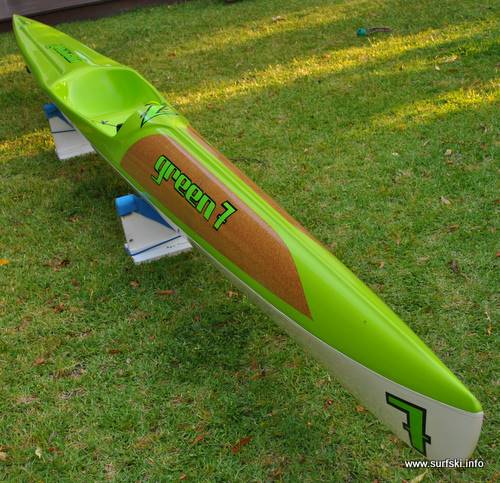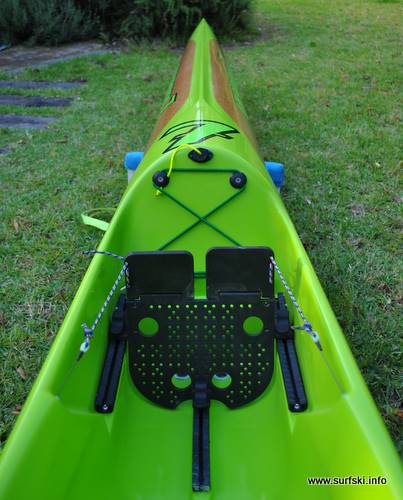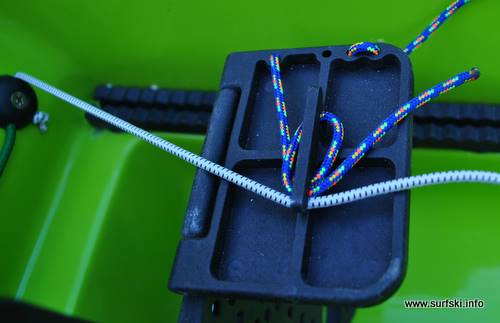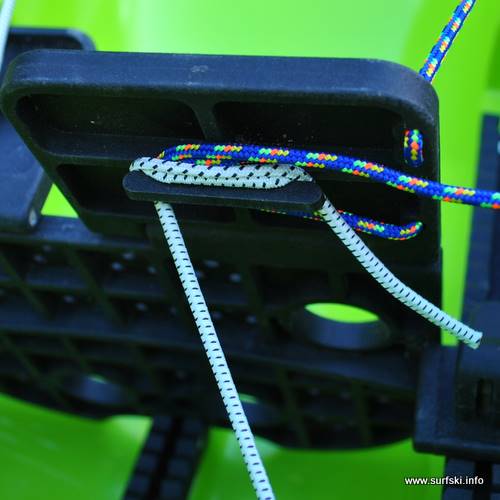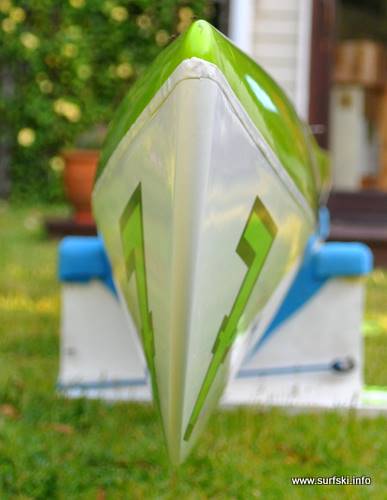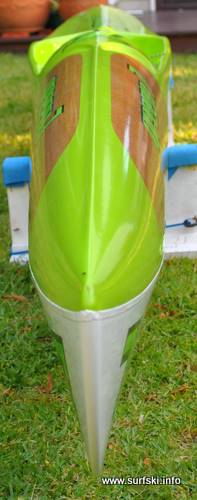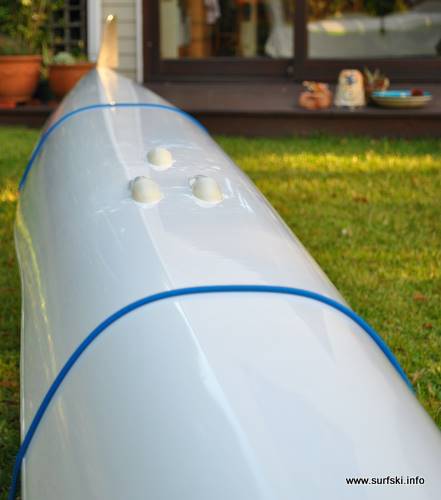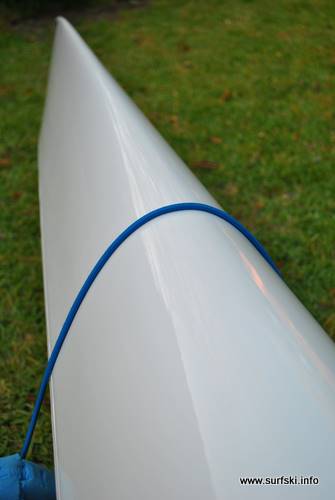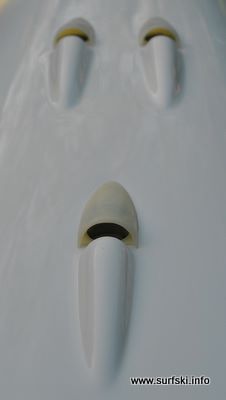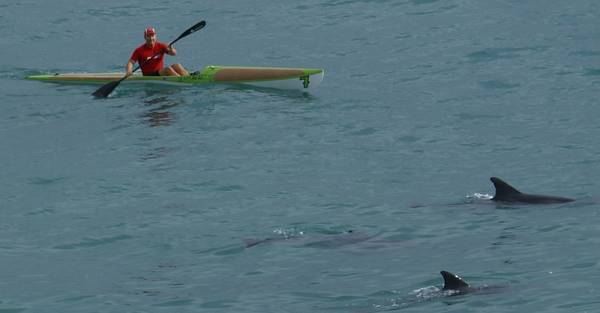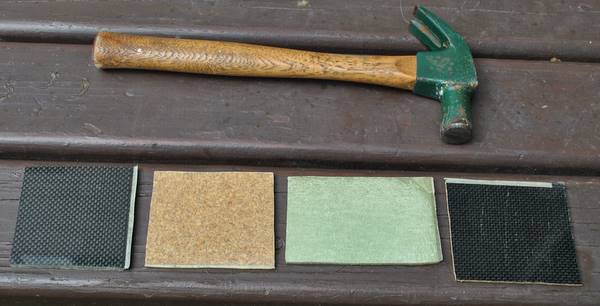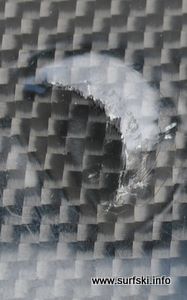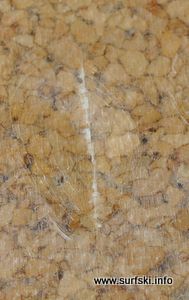Surfski.info Review - Green7
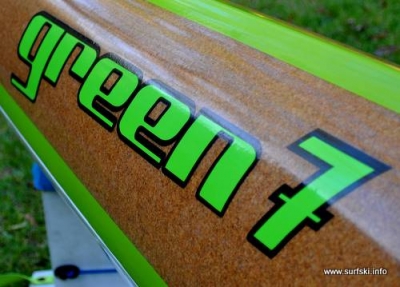 Green7
Green7
Bling Special… This ski turns heads on the beach – and is one of the nicest boats I’ve ever paddled.
First looks
Weight
The first (pre-production) Green7 that I paddled was lighter; this one is a production boat and it weighs in at around 14kg; somewhere between a carbon and conventional glass ski.
Green7 - Bling Special!
Finish
Red7 has suffered in the past from an indifferent reputation for quality. But this seems to have been sorted out since Red7 stopped manufacturing the boats themselves. Since their factory burnt down, the skis have been manufactured in Durban by Republic Sports/Eric’s Canoe Shop (glass) and in Port Elizabeth by Carbonology Sport (carbon and cork composite). I’ve seen several – both cork-composite and carbon and the quality of the finish is on a par with other leading manufacturers.
My boat came with a transparent gelcoat panel on the front deck – and it looks great.
Rudder Cables
The rudder cables used by Carbonology Sport on the Green7 comprise fishing trace wire sheathed in a plastic coating. The cables are light but strong.
Foot Plate and Rudder Pedal Adjustment
Although the Green7 doesn’t have the automatically adjusting rudder cables found on some skis, the rudder pedal adjustment is easy enough. I wouldn’t attempt it at sea though.
Green7 3-anchor-point footplate
The Green7’s footplate is anchored with a unique three-point mechanism. It’s the most solid, rigid footplate I’ve used yet.
Green7 pedal adjustment - first the rudder cable
Green7 rudder pedal adjustment complete
The rudder cables are attached to the pedals via a cleat arrangement. The cable ends are wrapped around the cleats; then bungie cord is wrapped around the cables. It’s a simple mechanism and you don’t need any tools to adjust it.
Green7 side view - click here for a larger image
Green7 top view - click here for a larger image
Paddling the Green7
(The handling overall is very similar to the original Red7 Surf70 Pro which I reviewed two years ago – read that review here.)
Cockpit comfort
As noted in my original review, the layout of the cockpit is extremely comfortable in terms of paddler positioning. Your heels are positioned lower than your butt, and the hull narrows at the catch.
Stability
I find the ski reasonably stable; similar to the Fenn Mako Elite or the Epic V10. I wouldn’t recommend it for a beginner, but intermediate paddlers shouldn’t have a problem with it.
Upwind performance
The Green7 goes nicely upwind – and I particularly appreciate the shape of the nose which catches the wind less than some other skis. (When paddling out to Bakoven Rock at the beginning of our favorite downwind Millers Run, we go at a diagonal into strong wind and big waves. When you launch over the waves, nose in the air, some skis with slab-sided noses are thrown violently sideways by the wind.)
Green7 nose cross-section
Downwind performance
The Green7 performs well in downwind conditions.
It catches small bumps easily and holds them well.
Some skis have a tendency to bury their nose in bigger conditions… And there’s nothing more frustrating than tearing down the face of a wave only to stop dead as you hit the wave in front. The Green7’s nose is designed to prevent this – in two ways. The cross-section of the nose widens rapidly so that the volume (and buoyancy) increases and reduces the tendency to nose dive. And the sharp ridge that runs the length of the deck makes it efficient at shedding water. The nett effect is that the ski seldom buries its nose – and even when it does it pops up immediately without stopping the boat.
That ridge helps the foredeck shed water
The Green7 has exceptional directional stability – and handles really well when going diagonally downwind when some skis show a tendency to broach. The Green7 holds its line as though it’s travelling on rails.
Turning
Of course “exceptional directional stability” can be read as “turns slowly”! The only criticism I have of the Green7 is its turning ability; it has one of the widest turning circles of any ski. But this is really only a disadvantage in round-the-cans type races; in downwind conditions it’s not so much of a concern.
I think the main cause is the flat rocker and I doubt that any rudder would make a substantial difference. However I do feel that the rudder doesn’t help the situation – it has a narrow, flat section and stalls easily. I think the apotheosis of rudder design is the Epic surfing rudder as found on the V10 and V12; the key to its efficiency is the airfoil section that, although it appears “fat”, grips the water and exhibits far less tendency to stall than flat-section rudders.
I’m working on my paddling buddy (and craftsman in carbon) Dale Lippstreu to persuade him to build me a rudder for the Green7. I have used his rudders on my old Fenn Mako6 and my current Mako Elite and they make an appreciable improvement to the maneuverability of the skis.
Green7 hull profile at the cockpit
Green7 hull profile at the nose
Safety
In my opinion there are two aspects to the Green7 that enhance the ski’s safety:
- The cockpit is relatively shallow so that it’s one of the easier skis to remount.
- And the scuppers drain the cockpit so efficiently that if you do flood the cockpit, the water disappears almost before you notice it. (I once paddled a prototype ski whose scuppers were too small, in hectic downwind conditions. The cockpit filled with water and the ski became almost uncontrollable. It was a very unpleasant experience.)
Scuppers
The bullet scuppers where designed with the aid of fluid dynamics computer modeling which shows that a) the bullets increase the rate of flow of water through the drain holes and b) the drag induced by the three bullet scuppers is equivalent to only one conventional scupper.
Green7 Bullet Scuppers
Not only does the cockpit drain in an instant, but the constant gurgling sound adds to the sensation of speed! As you go faster, so the pitch of the sound increases – like a kind of aural speed indicator.
What I like
- Scuppers: I hate to be in big waves in a sluggish, waterlogged ski. Knowing that the cockpit will empty itself on a single wave makes me feel safe – and of course faster.
- The foredeck: The ski seldom buries its nose, and even if it does, it pops up immediately.
- Comfort: The Green7 is one of the most comfortable skis I’ve paddled.
- Three-point footplate: Strong and rigid, you can push your heel against it as hard as you like.
- Finish: This boat turns heads on the beach – surfski bling!
The directional stability: The ski handles well in diagonal chop.
What I don’t like
- The directional stability(!): It’s frustrating to turn wide around buoys during a race!
- Rudder cables: On my boat the cables have started to stick a little – I push the rudder pedal and there’s a small amount of resistance before the rudder turns. I think it’s the sheathing on the cables that is sticking and I’m replacing the cables with conventional stainless steel.
In its element! Wayne Oosthuizen paddling with dolphins
Cork – the material
Hein van Rooyen of Carbonology Sport sent me a couple of panels made from different materials:
- Glass/cork
- Glass/foam
- Carbon/cork
- Carbon/foam
“Give them a bash with a hammer,” he said, “and see what you think of the toughness of the materials.”
The samples - and the trusty claw hammer!
Feeling a little self-conscious, I belted each of the panels with my trusty claw hammer. Unsurprisingly the glass/foam and carbon/foam composite pieces were the worst damaged, with the deepest dents and worst penetration of the surface.
The dents on the two cork composite pieces were not nearly as deep – and after a day had almost disappeared. Why? The cork has elastic memory and tends to resume its prior shape.
carbon/foam composite
glass/cork composite
So, certainly from the perspective of “dings” the cork composite material seems to be amazingly robust.
Is the ski as strong as conventional boats? Time will tell. The skis have a layer of Kevlar under the cockpit and this one is slightly more rigid than the first pre-production boat that I paddled.
For more info:
Red7's website is at: http://www.red7.co.za/
Are you a manufacturer in South Africa who would like to try cork?
Wayne Oosthuizen, Red7 CEO wrote, “A local company, Techno Cork Solutions, has been established to market and distribute the cork core sourced from Amorim in Portugal. The e-mail address is This email address is being protected from spambots. You need JavaScript enabled to view it.. The intention is get more ski and boat manufacturers in SA to adopt cork as a coring solution.
“The core thickness can vary from 2mm to 200mm depending on the application.”
Click here for more info on the cork.
More Reviews
For more reviews and alternative viewpoints, check out Wes Echols' website: http://surfskiracing.com/surfski_review_main.html


